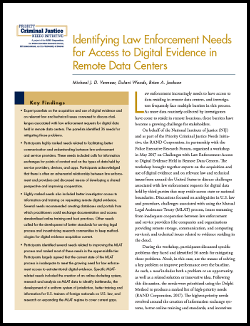
This report aims to improve legitimate law enforcement access to and use of remotely held digital evidence in a manner that is legal, effective, timely, and understandable, with a focus on the discussion of the expert panel that addressed this issue.
This issue is significant because state and local law enforcement agencies, in their investigations of crimes in their jurisdictions, increasingly need to obtain data and digital evidence held extraterritorially or by transnational companies. In addressing this issue, the expert panelists called for information exchanges for points of contact and on the types of data held by service providers, devices, and apps. The panelists acknowledged that an adversarial relationship often exists between law enforcement and various data sources. The panelists discussed means of developing a shared perspective and improving cooperation. Participants also identified several needs related to improving the Mutual Legal Assistance Treaty (MLAT) process. There was large agreement that the current state of the MLAT process is not meeting the increasing need for law enforcement access to extraterritorial digital evidence. Suggestions include the creation of an online docketing system; research and analysis on MLAT data to identify bottlenecks; the development of a uniform system of jurisdiction; better training and information for U.S. trainers of foreign nationals on U.S. law; and research on expanding the MLAT regime to cover current gaps. Other recommendations pertain to training for investigators on the creation and appropriate bounding of requests to providers for data; better standards for the creation of and compliance with data requests to providers; and improved communication between law enforcement investigators and service providers.
